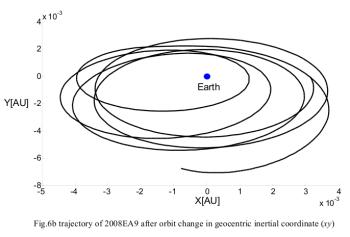Capturing an asteroid into Earth orbit

Want to mine an asteroid? Rather than travel to it with all their mining equipment, three Chinese scientists have proposed a better way. In a paper published today on the Los Alamos astro-ph preprint website, they have calculated the energy required to shift the orbits of the six thousand near-Earth asteroids and place them in Earth orbit for later mining. Of these, they found 46 asteroids that had the potential for such an operation, and two likely candidates for a space mission. One 30-foot-wide asteroid, 2008EA9, will actually be in the right place for this technique in 2049. As they write,
It can be seen that the velocity increment of the 2008EA9 is relatively small (-1.00km/s) and it will very close approach [approximately 645,000 miles] to the Earth in [February] 2049. Moreover the size of the NEO 2008EA9 is very small so that the capturing of it is relatively easy.
The real problem, of course, is adding that small “velocity increment” to the asteroid.
You can give the asteroid a quick push, using “conventional explosive, kinetic impactor, or nuclear explosive.” The problem with these techniques is that you have to have a very precise understanding of the composition, density, and make-up of the asteroid. For example, an impactor hitting a rubble pile will have far less success in moving it than if that asteroid was a dense solid body. Worse, an explosion might rip a rubble pile apart, sending the wreckage on a collision course with Earth. To put it mildly, such an event would have serious liability concerns for any private company.
A better method might be to give the asteroid a slow and steady push over a long time, using a space tug, a nearby heavy mass, or a beam of light — either from focused solar light or a pulsed laser — all of which slowly drag the asteroid into its new orbital path. Even here, however, it is necessary to have a better understanding of the asteroid before launching such a the tractor mission.
While at first glance all of this appears to be science fiction fantasy, the mining of asteroids has gigantic economic potential. As the scientists note, “a two kilometer-size metallic [near Earth object], for example, may contain rich metals and materials worth more than 25 trillion dollars.”
In other words, forget about science and political considerations. There is a real commercial need to mount a scouting mission to these near-Earth asteroids. And it appears the Chinese are thinking about this seriously, considering this is the second paper on the subject of accessing and adjusting the orbits of near-Earth asteroids to appear from them in less then two weeks.
On Christmas Eve 1968 three Americans became the first humans to visit another world. What they did to celebrate was unexpected and profound, and will be remembered throughout all human history. Genesis: the Story of Apollo 8, Robert Zimmerman's classic history of humanity's first journey to another world, tells that story, and it is now available as both an ebook and an audiobook, both with a foreword by Valerie Anders and a new introduction by Robert Zimmerman.
The print edition can be purchased at Amazon or from any other book seller. If you want an autographed copy the price is $60 for the hardback and $45 for the paperback, plus $8 shipping for each. Go here for purchasing details. The ebook is available everywhere for $5.99 (before discount) at amazon, or direct from my ebook publisher, ebookit. If you buy it from ebookit you don't support the big tech companies and the author gets a bigger cut much sooner.
The audiobook is also available at all these vendors, and is also free with a 30-day trial membership to Audible.
"Not simply about one mission, [Genesis] is also the history of America's quest for the moon... Zimmerman has done a masterful job of tying disparate events together into a solid account of one of America's greatest human triumphs."--San Antonio Express-News


yes ! we have seemingly infinate resources and space if we can expand our horizon beyond the planet we were born on . cool post^
I’m in favor of bringing the rocks to Earth orbit where it will be much easier to mine them, and where the solar flux is dense enough to make solar-powered mining viable. The problem is that altering orbits to do that is probably politically impossible. Even a small rock of 10m diameter would create an airburst of around 20 KT if it ‘got loose’ (source: http://impact.ese.ic.ac.uk/ImpactEffects/), about the size of the bomb used against Nagasaki. The model suggests that even those standing directly under the blast wouldn’t be affected due to the high altitude of the explosion, but there is the possibility of getting hit by very energetic fragments. I just don’t see it happening. Lunar orbit may be the best future miners can hope for, and that wouldn’t be too much of a hardship.
I would be nice to know either the names of the investigators or have a definite reference to the paper.
arXiv:1108.4767
Authors:
Hexi Baoyin, Yang Chen, Junfeng Li
A direct link to the paper was included in my post.